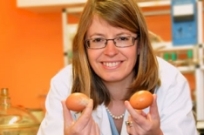New test: free-range, organic, or caged?

A New Zealand researcher has developed a scientific technique to identify the difference between eggs from caged hens and those from free-range and organically raised hens.
It is believed to be the first time that eggs from different farming systems have been distinguished by using isotope analysis.
Karyne Rogers, of GNS Science’s National Isotope Centre in Lower Hutt, compared different brands of off-the-shelf eggs from caged, barn, free-range and organic farming regimes.
Using isotope analysis, Dr Rogers found almost all the eggs could be differentiated by relating the carbon and nitrogen found in the egg to the hen’s diet. This is possible as diet directly reflects the type of farming environment where the hens were raised.
“Free-range and organically farmed hens normally have access to a wider range of food sources than caged hens, such as insects, vegetation or organic feeds, and this changes the isotope fingerprint of their eggs,” Dr Rogers said.
The findings recently published in an international publication, the Journal of Agricultural and Food Chemistry, show that isotope analysis is a potentially useful technique for identifying eggs from different farming regimes.
The research was performed on egg yolk, albumen, and egg membrane, to see which egg components gave the best information about the hen’s diet. Dr Rogers said the technique held considerable promise for the egg industry as an effective verification tool to guard against mis-labelling.
“The technique is a good way to scientifically prove that eggs are truly free-range or organic… The next step is to seek industry funding to work directly with egg producers to further refine the technique so it can be fully tested and applied in the industry,” said Dr Rogers, adding that New Zealand exports more than 2 mln free-range eggs a year and that this test could provide added consumer confidence, which would give New Zealand an advantage in export markets.
Source: Geological and Nuclear Sciences













